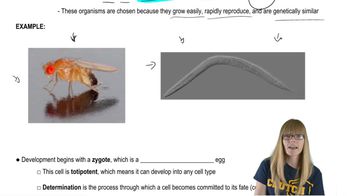Contrast the various types of DNA repair mechanisms known to counteract the effects of UV radiation. What is the role of visible light in repairing UV-induced mutations?
Table of contents
- 1. Introduction to Genetics51m
- 2. Mendel's Laws of Inheritance3h 37m
- 3. Extensions to Mendelian Inheritance2h 41m
- 4. Genetic Mapping and Linkage2h 28m
- 5. Genetics of Bacteria and Viruses1h 21m
- 6. Chromosomal Variation1h 48m
- 7. DNA and Chromosome Structure56m
- 8. DNA Replication1h 10m
- 9. Mitosis and Meiosis1h 34m
- 10. Transcription1h 0m
- 11. Translation58m
- 12. Gene Regulation in Prokaryotes1h 19m
- 13. Gene Regulation in Eukaryotes44m
- 14. Genetic Control of Development44m
- 15. Genomes and Genomics1h 50m
- 16. Transposable Elements47m
- 17. Mutation, Repair, and Recombination1h 6m
- 18. Molecular Genetic Tools19m
- 19. Cancer Genetics29m
- 20. Quantitative Genetics1h 26m
- 21. Population Genetics50m
- 22. Evolutionary Genetics29m
17. Mutation, Repair, and Recombination
DNA Repair
Problem 22b
Textbook Question
You have identified five genes in S. cerevisiae that are induced when the yeast are grown in a high-salt (NaCl) medium. To study the potential roles of these genes in acclimation to growth in high-salt conditions, you wish to examine the phenotypes of loss- and gain-of-function alleles of each. How would your answer differ if you were working with tomato plants instead of yeast?
 Verified step by step guidance
Verified step by step guidance1
Step 1: Understand the difference in genetic manipulation techniques between yeast (S. cerevisiae) and tomato plants. Yeast is a single-celled organism that can be genetically manipulated relatively easily using techniques like homologous recombination and CRISPR-Cas9. Tomato plants, being multicellular and more complex, require different approaches such as Agrobacterium-mediated transformation or biolistic methods for introducing genetic changes.
Step 2: Consider the growth conditions and experimental setup. Yeast can be grown in controlled liquid media with high-salt conditions, allowing for rapid phenotypic analysis. Tomato plants, on the other hand, require soil or hydroponic systems, and phenotypic analysis may take longer due to their slower growth and development.
Step 3: Account for the differences in gene expression analysis. In yeast, gene expression can be studied using techniques like RNA sequencing or qPCR directly from cultures. In tomato plants, tissue-specific expression must be considered, and samples may need to be collected from specific organs (e.g., leaves, roots) for analysis.
Step 4: Plan for phenotypic evaluation. In yeast, phenotypes such as growth rate or survival in high-salt conditions can be assessed directly in culture. In tomato plants, phenotypes might include changes in growth, leaf morphology, or fruit production under high-salt conditions, requiring more complex observational methods.
Step 5: Adapt the experimental design for genetic studies. Loss-of-function alleles in yeast can be created by gene knockout or deletion, while in tomato plants, RNA interference (RNAi) or CRISPR-Cas9 can be used. Gain-of-function alleles in yeast can be introduced via plasmid overexpression, whereas in tomato plants, transgenic approaches or overexpression constructs integrated into the genome are required.
 Verified video answer for a similar problem:
Verified video answer for a similar problem:This video solution was recommended by our tutors as helpful for the problem above
Video duration:
2mPlay a video:
Was this helpful?
Key Concepts
Here are the essential concepts you must grasp in order to answer the question correctly.
Gene Function and Alleles
Genes are segments of DNA that encode proteins, which perform various functions in an organism. Alleles are different versions of a gene that can result in variations in traits. Understanding loss-of-function alleles (which disrupt gene function) and gain-of-function alleles (which enhance or change gene function) is crucial for studying how specific genes contribute to an organism's response to environmental stressors, such as high salt concentration.
Recommended video:
Guided course

Functional Genomics
Model Organisms in Genetics
Model organisms, like S. cerevisiae (yeast) and tomato plants, are species widely used in genetic research due to their well-characterized genomes and ease of manipulation. While yeast is a unicellular organism that allows for rapid genetic studies, tomato plants are multicellular and exhibit more complex traits, including developmental and physiological responses to environmental changes. This difference influences experimental design and interpretation of results.
Recommended video:
Guided course

Genetics of Development
Phenotypic Analysis
Phenotypic analysis involves studying the observable characteristics of an organism resulting from the interaction of its genotype with the environment. In the context of high-salt acclimation, examining phenotypes of different alleles helps determine how specific genes affect the organism's ability to cope with stress. The approach to phenotypic analysis may vary between yeast and tomato plants due to differences in growth conditions, developmental stages, and the complexity of traits being studied.
Recommended video:
Guided course

Chi Square Analysis
Related Videos
Related Practice
Textbook Question
746
views


